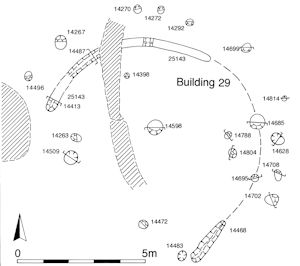
Within Development Area A2, the full width of Open Area 27 is exposed, as defined between ditches 25075 (Group 143) and 25081 (Group 146). At least part of its frontage along Road/track 3 is fenced and its southern (rear) boundary is presumed to coincide with the edge of the lower gravel terrace.
Like Open Area 28, the remains occupying the interior of Open Area 27 display a degree of complexity that infers continuous activity during Period 2B. Some attempt is made here to describe the identifiably earlier elements of this occupation activity. Later features are described in Southern zone, Open Area 27 (second phase of activity) and the latest ones in Southern zone, Open Area 27 (third phase of activity).

The presence of circular Building 29 is defined by curving slot 25143 (segs 14337, 14413, 14468, 14487, Group 242), which survives as an arc some 8.00m long on the north side of the building and an additional short length (14468) on its south side (Figure 41). It seems unlikely that these slots originally extended further, or that additional slots to complete the circular foundation were missed during excavation, as this area was intensively investigated. A number of post-holes (14483, 14685, 14695, Group 243) along the extrapolated circumference may be integral parts of this structure. The extant remains define a building of c. 8-8.5m in diameter. Immediately to the north of slot 25143, a line of similar post-holes (14267, 14270, 14272, 14292, 14628, 14699, 14702, 14708, 14814, Group 245) follows its curve, perhaps denoting a more elaborate structure, but could equally be an enclosing fence around the building. An entrance to the building from the south-west, the quadrant least encumbered by either structural slots or post-holes, is possible. A large number of post-holes/small pits (Group 244) lie within the building; these are either further structural elements or are associated with the use of the building. Post-hole 14598 may define the location of a central roof support, were one present, and a very tentative inner ring of smaller post-holes can be discerned (14398, 14788, 14804, 14472, 14263).
While none of the small quantities of indifferent pottery from Building 29 contexts can be closely dated, it is nevertheless consistent with a Late Iron Age or early Roman date.
The earliest phase of activity in OA27 in this period is characterised by pitting. Some (Groups 246, 247, 752) form a dense inter-cutting cluster near the boundary, east of Building 29. The finds suggest the groups can be subdivided on chronological grounds, in that the pits 15842, 15850, 15882, 24115 (Group 247) contain material of firmly Late Iron Age, rather than transitional, date. Pit 24115 is the only pit within this group whose infilling can be demonstrated to extend into the middle third of the 1st century AD, with a Claudian copy coin and a Colchester BB brooch. These pits tend to be large, at around 1.5m to 2m diameter; 24115 being very large indeed. In relation to the large volumes of these pits, finds were fairly sparse, and assemblages not particularly varied.
Pits 24181, 24184, 24186 (Group 246), although also possibly Late Iron Age, contain items such as Langton Down brooch SF7820 (in 24181) that could be mid-1st century AD. The Group 247 pits post-date Group 246 and the latter could perhaps be regarded as Period 2A. However, as they appear to post-date pit 24247 (Group 752), which although intrinsically undated is treated as a Period 2B feature, they are included here.
Pits 14533, 14545, 14649, 14947, 14980, 20030, 20067, 20069, 20095 and 20100 (Group 248) are spread widely over the western part of OA27 but display a tendency to loose clustering and occasional inter-cutting. These pits, are either large and circular (2.5m to 3m+) or small and circular to oval (less than 1.5m) and are infilled during the first half of the 1st century AD. The absence of loomweight fragments from their fills is conspicuous and metalworking debris is less common, with the exception of the copper-alloy cast waste from pit 20030 and perhaps also from pit 14533. The majority of pits contain typical assemblages of pottery together with modest quantities of briquetage, animal bone and occasional items of metalwork.
Pits 14223 and 14231 (Group 258) pre-date Building 36
Lastly, Late Iron Age pit 15968 (Group 141) cuts the eastern enclosure boundary, ditch 25082, demonstrating that as an active ditch it soon fills and presumably passes out of use prior to it being replaced by ditch 25081, which cuts the infilled pit. The pit contains pottery, briquetage and two iron nails.
Internet Archaeology is an open access journal based in the Department of Archaeology, University of York. Except where otherwise noted, content from this work may be used under the terms of the Creative Commons Attribution 3.0 (CC BY) Unported licence, which permits unrestricted use, distribution, and reproduction in any medium, provided that attribution to the author(s), the title of the work, the Internet Archaeology journal and the relevant URL/DOI are given.
Terms and Conditions | Legal Statements | Privacy Policy | Cookies Policy | Citing Internet Archaeology
Internet Archaeology content is preserved for the long term with the Archaeology Data Service. Help sustain and support open access publication by donating to our Open Access Archaeology Fund.